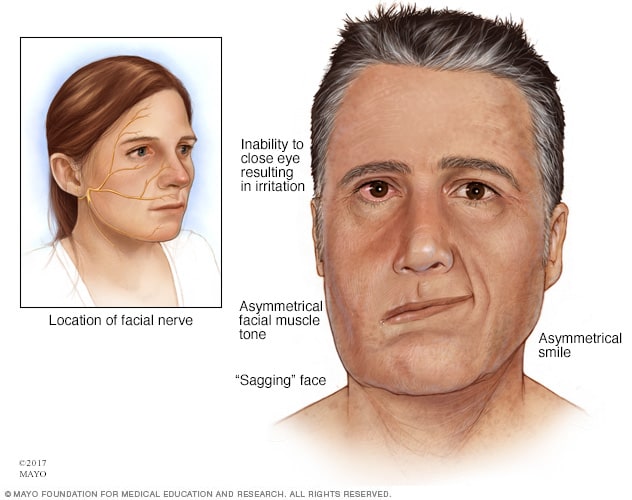,,,,,,,,,,,,,,,,,,,,,,,,,,,,,,,,,,,,,,,,,,,,,,,,,,,,,,,,,,,,,,,,,,,,,,,,,,,,,,,,,,,,,,,,,,,,,,,,,,,,,,,,,,,,,,,,,,,,,,,,,,,,,,,,,,,,,,,,,,,,,,,,,,,,,,,,,,,
Bell's palsy
Although the exact reason Bell's palsy
occurs isn't clear, it's often related to exposure to a viral infection
By Mayo
Clinic Staff
Overview
Bell's palsy causes sudden, temporary weakness
in your facial muscles. This makes half of your face appear to droop. Your
smile is one-sided, and your eye on that side resists closing.
It's believed to be the result of swelling and
inflammation of the nerve that controls the muscles on one side of your face.
Or it might be a reaction that occurs after a viral infection.
For most people, Bell's palsy is temporary.
Symptoms usually start to improve within a few weeks, with complete recovery in
about six months.
A small number of people continue to have some
Bell's palsy symptoms for life. Rarely, Bell's palsy can recur.
Symptoms
Signs and symptoms of Bell's palsy come on
suddenly and may include:
Rapid onset of mild weakness to total paralysis
on one side of your face — occurring within hours to days
Facial droop and difficulty making facial
expressions, such as closing your eye or smiling
Drooling
Pain around the jaw or in or behind your ear on the
affected side
Increased sensitivity to sound on the affected
side
Headache
A decrease in your ability to taste
Changes in the amount of tears and saliva you
produce
In rare cases, Bell's palsy can affect the
nerves on both sides of your face.
When to see a doctor
Seek immediate medical help if you experience
any type of paralysis because you may be having a stroke. Bell's palsy is not
caused by a stroke, but it can cause similar symptoms.
See your doctor if you experience facial
weakness or drooping to determine the underlying cause and severity of the
illness.
Causes
Although the exact reason Bell's palsy occurs
isn't clear, it's often related to exposure to a viral infection. Viruses that
have been linked to Bell's palsy include the virus that causes:
Cold sores and genital herpes (herpes simplex)
Chickenpox and shingles (herpes zoster)
Infectious mononucleosis (Epstein-Barr)
Cytomegalovirus infections
Respiratory illnesses (adenovirus)
German measles (rubella)
Mumps (mumps virus)
Flu (influenza B)
Hand-foot-and-mouth disease (coxsackievirus)
The nerve that controls your facial muscles
passes through a narrow corridor of bone on its way to your face.
In Bell's palsy, that nerve becomes inflamed and
swollen — usually related to a viral infection.
Besides facial muscles, the nerve affects tears,
saliva, taste and a small bone in the middle of your ear.
Risk factors
Bell's palsy occurs more often in people who:
Are pregnant, especially during the third
trimester, or who are in the first week after giving birth
Have an upper respiratory infection, such as the
flu or a cold
Have diabetes
Recurrent attacks of Bell's palsy are rare. But
in some of these cases, there's a family history of recurrent attacks —
suggesting a possible genetic predisposition to Bell's palsy.
Complications
A mild case of Bell's palsy normally disappears
within a month. Recovery from a more severe case involving total paralysis
varies. Complications may include:
Irreversible damage to your facial nerve
Abnormal regrowth of nerve fibers, resulting in
involuntary contraction of certain muscles when you're trying to move others
(synkinesis) — for example, when you smile, the eye on the affected side may
close
Partial or complete blindness of the eye that
won't close due to excessive dryness and scratching of the clear protective covering
of the eye (cornea)
Mayo
Clinic Staff
The
product development team consists of experts in content development and
production, product management, and user experience and design. Because
physicians, scientists and other medical experts dedicate a portion of their
clinical time to this site, we are in the unique position to give you access to
the knowledge and experience of Mayo Clinic.


No comments:
Post a Comment